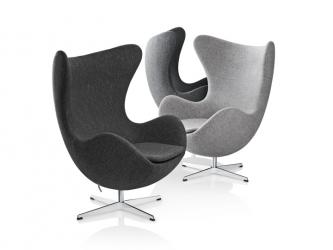Though he didn’t always plan on designing chairs, Arne Jacobsen was a born artist. The Copenhagen architect began his schooling in 1924 after his father urged him to pick a more “practical” career than painting. While studying architecture at the Royal Danish Academy of Fine Arts, Jacobsen won his first medal in chair design during the 1925 Paris Art Deco Fair. This would be the first foray of many into the interior and furniture design world, setting the basis for his designs’ future success.
Jacobsen went on to become a world-renowned architect and furniture designer known for his keen understanding of ergonomics and love for a futuristic style. In 1958, the SAS Royal Hotel in Copenhagen contracted Jacobsen to design every aspect of their building, including all its furniture. One of Jacobsen’s most famous pieces, the Egg chair, came to life in the SAS’s lobby and reception areas.
Jacobsen designed the Egg chair to contrast the building’s overall design, which consisted largely of vertical and horizontal straight lines and surfaces. The Egg chair’s soft curves worked to draw in customers for a relaxing stay at the otherwise imposing and grand hotel. To achieve such soft curves that could maintain their shapes over time, Jacobsen used a new technique that he developed, utilizing a strong inner foam shell beneath the luxury upholstery. A true Egg chair today comes in a wide range of colors and fabric, but the main components of the chair stay the same, such as the star-shaped aluminum base.
Though Arne Jacobsen’s original design remains quite pricey, the Egg chair has inspired hundreds of other similar and more affordable pieces that have helped it stand the test of time. By manufacturing these similar seats, the Egg chair’s legacy lives on across the world in homes and hotels alike.





